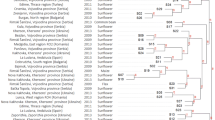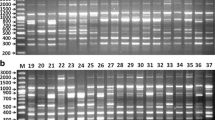Abstract
Restriction fragment length polymorphism (RFLP) at the ribosomal RNA gene loci (rDNA) was investigated in 227 accessions of taro, Colocasia esculenta (L.) Schott, from China, Japan, Taiwan, and Vietnam. Eighteen different restriction fragment patterns of rDNA were observed. The results were largely consistent with a previous classification based on isozyme data. Some rDNA patterns were distributed extensively in the temperate zone from inland China to Japan. On the other hand, some other patterns ranged in coastal and/or insular areas from the tropical zone to the temperate zone (Japan). These geographical distributions may suggest two different routes for the introduction of taro into Japan: one from China,and the other most likely from Southeast Asia, via Taiwan and the Ryukyu Islands (southern Japan).
Similar content being viewed by others
References
Ankei, Y., 1985. Taro in Iriomote Island: its traditional cultivation and utilization. Technol Agric (Nokou no Gijutsu) 8: 1–27 (in Japanese).
Appels, R. & J. Dvorak, 1982. The wheat ribosomal DNA spacer region: its structure and variation in populations and among species. Theor Appl Genet 63: 337–348.
Coates, D.J., D.E. Yen & P.M. Gaffey, 1988. Chromosome variation in taro, Colocasia esculenta: implications for origin in the Pacific. Cytologia 53: 551–560.
Domros, M. & G. Peng, 1988. The Climate of China. Springer, Berlin.
Fukushima, E., S. Iwasa, S. Tokumasu & M. Iwamasa, 1962. Chromosome number of the taro varieties in Japan. Chromosome Inf Serv 3: 38–39.
Hotta, M., 1970. A system of the family Araceae in Japan and adjacent areas I. Mem Fac Sci Kyoto Univ Ser Biol 4: 72–96.
Irwin, S.V., P. Kaufusi, K. Banks, R. de la Pena & J.J. Cho, 1998. Molecular characterization of taro (Colocasia esculenta) using RAPD markers. Euphytica 99: 183–189.
Isshiki, S., M. Nakada, N. Nakamura, Y. Tashiro & S. Miyazaki, 1995. Genetic systems and variations of isozymes in wild taro (Colocasia esculenta Schott) from Bangladesh. J Jpn Soc Hortic Sci 64: 113–119.
Isshiki, S., K. Otsuka, Y. Tashiro & S. Miyazaki, 1999. A probable origin of triploids in taro (Colocasia esculenta (L.) Schott). J Jpn Soc Hortic Sci 68: 774–779.
Kawahara, T., 1978. Chromosome number of taros in Nepal and India. Chromosome Inf Serv 24: 4–5.
Kumazawa, S., K. Niuchi & F. Honda, 1956. Classification of the taro varieties in Japan. J Jpn Soc Hortic Sci 25: 1–10 (in Japanese).
Kuruvilla, K.M. & A. Singh, 1981. Karyotypic and electrophoretic studies on taro and its origin. Euphytica 30: 405–413.
Lebot, V. & K.M. Aradhya, 1991. Isozyme variation in taro (Colocasia esculenta (L.) Schott) from Asia and Oceania. Euphytica 56: 55–66.
Lebot, V., 1999. Biomolecular evidence for plant domestication in Sahul. Genet Res Crop Evol 46: 619–628.
Matsuda, M. & E. Nawata, 1999. Isozyme variation in taro, Colocasia esculenta (L.) Schott, from China, Taiwan, the Ryukyu Islands, and Japan: its dispersal into Japan. Tropics 8: 397–407.
Matthews, P.J., 1990. The Origins, Dispersal and Domestication of Taro. PhD, Aust Natl Univ, Canberra.
Matthews, P.J., Y. Matsushita, T. Sato & M. Hirai, 1992. Ribosomal and mitochondrial DNA variation in Japanese taro (Colocasia esculenta L. Schott). Jpn J Breed 42: 825–833.
Matthews, P.J., 1995. Aroids and the Austronesians. Tropics 4: 105–126.
Matthews, P.J., 1997. Field guide for wild-type taro, Colocasia esculenta (L.) Schott. Plant Genet Resour Newsl 110: 41–48.
Murray, M.G. & W.F. Thompson, 1980. Rapid isolation of high molecular weight plant DNA. Nucl Acid Res 8: 4321–4325.
National Astronomical Observatory (ed.), 1996. Chronological Science Tables. Maruzen, Tokyo (in Japanese).
Pho, N.V. (ed.), 1994. Vietnam Hydrometeorological Atlas. Vietnam National Committee for IHP, Hanoi.
Rogers, S.O. & A.J. Bendich, 1987. Ribosomal RNA genes in plants: variability in copy number and in the intergenic spacer. Plant Mol Biol 9: 509–520.
Segawa, K., 1953. The means of subsistence among the Formosan aborigines. Jpn J Ethnol 18: 49–66 (in Japanese with English summary).
Tanimono, T., 1998. Classification and dispersal of Japanese taro. Technol Culture Agric (Nokou no Gijutsu to Bunka) 21: 71–98 (in Japanese).
Yen, D.E. & J.M. Wheeler, 1968. Introduction of taro into the Pacific: the indications of the chromosome numbers. Ethnology 7: 259–267.
Author information
Authors and Affiliations
Rights and permissions
About this article
Cite this article
Matsuda, M., Nawata, E. Geographical distribution of ribosomal DNA variation in taro, Colocasia esculenta (L.) Schott, in eastern Asia. Euphytica 128, 165–172 (2002). https://doi.org/10.1023/A:1020825418469
Issue Date:
DOI: https://doi.org/10.1023/A:1020825418469




